wheel size SKODA FABIA 2014 2.G / 5J Owner's Manual
[x] Cancel search | Manufacturer: SKODA, Model Year: 2014, Model line: FABIA, Model: SKODA FABIA 2014 2.G / 5JPages: 197, PDF Size: 13.56 MB
Page 9 of 197
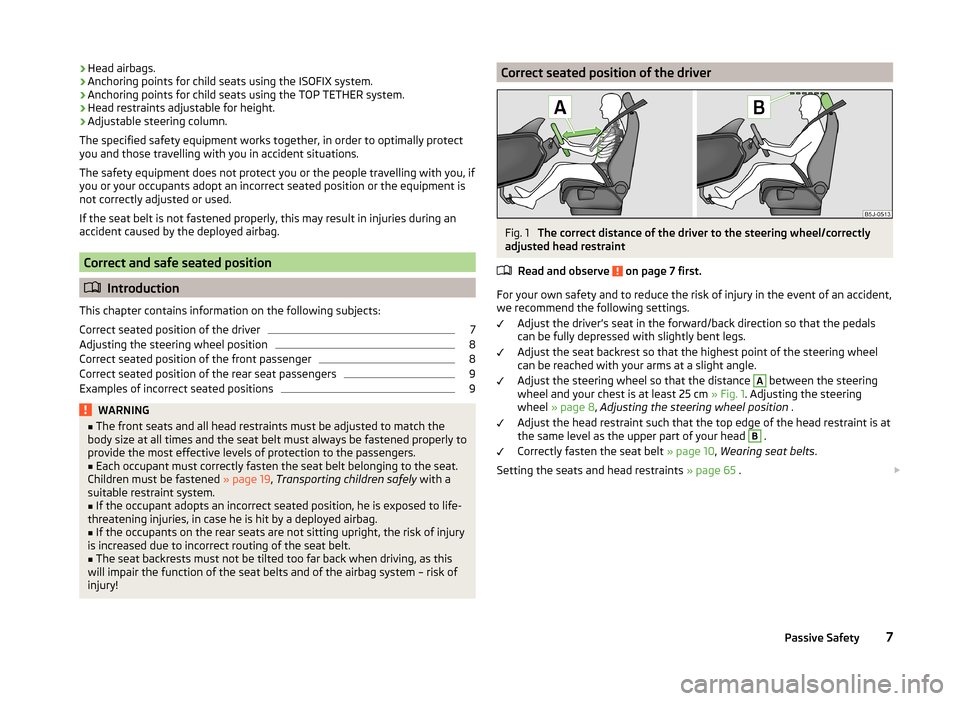
›Head airbags.
› Anchoring points for child seats using the ISOFIX system.
› Anchoring points for child seats using the TOP TETHER system.
› Head restraints adjustable for height.
› Adjustable steering column.
The specified safety equipment works together, in order to optimally protect you and those travelling with you in accident situations.
The safety equipment does not protect you or the people travelling with you, if
you or your occupants adopt an incorrect seated position or the equipment is not correctly adjusted or used.
If the seat belt is not fastened properly, this may result in injuries during an
accident caused by the deployed airbag.
Correct and safe seated position
Introduction
This chapter contains information on the following subjects:
Correct seated position of the driver
7
Adjusting the steering wheel position
8
Correct seated position of the front passenger
8
Correct seated position of the rear seat passengers
9
Examples of incorrect seated positions
9WARNING■ The front seats and all head restraints must be adjusted to match the
body size at all times and the seat belt must always be fastened properly to
provide the most effective levels of protection to the passengers.■
Each occupant must correctly fasten the seat belt belonging to the seat.
Children must be fastened » page 19, Transporting children safely with a
suitable restraint system.
■
If the occupant adopts an incorrect seated position, he is exposed to life-
threatening injuries, in case he is hit by a deployed airbag.
■
If the occupants on the rear seats are not sitting upright, the risk of injury
is increased due to incorrect routing of the seat belt.
■
The seat backrests must not be tilted too far back when driving, as this
will impair the function of the seat belts and of the airbag system – risk of
injury!
Correct seated position of the driverFig. 1
The correct distance of the driver to the steering wheel/correctly
adjusted head restraint
Read and observe
on page 7 first.
For your own safety and to reduce the risk of injury in the event of an accident,we recommend the following settings.
Adjust the driver’s seat in the forward/back direction so that the pedals
can be fully depressed with slightly bent legs.
Adjust the seat backrest so that the highest point of the steering wheel
can be reached with your arms at a slight angle.
Adjust the steering wheel so that the distance
A
between the steering
wheel and your chest is at least 25 cm » Fig. 1. Adjusting the steering
wheel » page 8 , Adjusting the steering wheel position .
Adjust the head restraint such that the top edge of the head restraint is at
the same level as the upper part of your head
B
.
Correctly fasten the seat belt » page 10, Wearing seat belts .
Setting the seats and head restraints » page 65 .
7Passive Safety
Page 16 of 197

Airbag system
Description of the airbag system
Introduction
This chapter contains information on the following subjects:
System description
14
Airbag deployment
14WARNING■ An airbag can only offer you optimal protection in combination with a fas-
tened seat belt.■
The airbag is not a substitute for the seat belt, but instead forms part of
the complete passive vehicle safety concept.
■
To ensure passengers are protected with the greatest possible effect
when the airbag is deployed, the front seats must be correctly adjusted to
match the body size » page 7, Correct and safe seated position .
■
If you do not fasten the seat belts when driving, lean too far forward or
adopt an incorrect seated position, you are exposing yourself to increased
risk of injury in the event of an accident.
WARNINGInformation on the use of the airbag system■If there is a fault, the airbag system must be checked by a specialist ga-
rage immediately. Otherwise, there is a risk of the airbag not being activa-
ted in the event of an accident.■
No modifications of any kind must be made to parts of the airbag system.
■
Any work on the airbag system including the installation and removal of
system components due to other repair work (e.g. removal of the steering
wheel) must only be carried out by a specialist garage.
■
Never make any changes to the front bumper or bodywork.
■
It is prohibited to tamper with individual parts of the airbag system as this
might result in the airbag being deployed.
■
The protective function of the airbag system is sufficient for only one ac-
cident. The airbag system must then be replaced if the airbag has been de-
ployed.
System description
Read and observe
on page 14 first.
The functional status of the airbag system is indicated by the
indicator light
in the instrument cluster » page 40.
When the airbags are deployed they fill with gas and inflate.
A grey white or red, non-harmful gas is released when the airbag is inflated.
This is perfectly normal and is not an indication of a fire in the vehicle.
The airbag system consists – depending on the vehicle equipment – of the
following modules.
› Electronic control unit.
› Front airbag for the driver and the front passenger
» page 15.
› Side airbags
» page 16.
› Head airbags
» page 17.
› Airbag indicator light in the instrument cluster
» page 40.
› Key switch for the front passenger airbag
» page 18.
› Warning light for front passenger airbag deactivation in dash panel cen-
tre » page 18 .
Note
■
The airbag system needs no maintenance during its working life.■If you sell your vehicle, provide the complete vehicle documentation to the
new owner. Please note that the information relating to the possibility of de-
activating the front passenger airbag must be included!■
When disposing of vehicle or parts of the airbag system, it is important to
comply with the national legal requirements.
Airbag deployment
Read and observe
on page 14 first.
The airbags inflate in fractions of a second and at a high speed in order to be
able to offer that additional protection in the event of an accident.
The airbag system is only functional when the ignition is switched on.
In certain accident situations, the several airbags may be deployed simultane-
ously.
The airbags are not deployed in the case of minor frontal and side collisions,
rear-end collisions, tilting of the vehicle and vehicle rollover.
14Safety
Page 18 of 197

WARNINGInformation on correct seating position■For the driver and front passenger, it is important to maintain a distance
of at least 25 cm from the steering wheel or dashboard A
» Fig. 9 . Not
keeping to this minimum distance will mean that the airbag system will not
be able to properly protect you – risk of death. The front seats and the
head restraints must always also be correctly adjusted to match the body
size of the occupant.
■
The airbag develops enormous forces when triggered, which can lead to
injuries if the sitting position or seated position is not correct.
■
There must not by any further persons, animals or objects positioned be-
tween the front seated occupants and the deployment area of the airbag.
WARNINGFront airbag and transporting children■Never transport children on the front seat of a vehicle without using a
proper restraint system. If airbags are deployed in the event of an accident,
the child might suffer severe or even fatal injuries!■
It is essential to switch off the front passenger airbag if you are using a
child seat on the front passenger seat in which the child is carried with its
back facing the direction of travel » page 17, Deactivating airbags . If this
is not done, there is a risk of the child suffering severe or even fatal injuries
if the front passenger airbag is deployed. When transporting a child on the
front passenger seat, pay attention to any relevant national regulations re-
garding the use of child safety seats.
WARNINGGeneral information■The steering wheel and the surface of the airbag module in the dash pan-
el on the passenger side must not have stickers attached, be covered or
modified in any other way. These parts should only be cleaned with a cloth
that is dry or has been moistened with water. No objects such as cup hold-
ers, mobile phone mounts, etc. must be attached to the covers of the air-
bag modules or be located within their immediate vicinity.■
Never place objects on the surface of the front passenger airbag module
in the dash panel.
Side airbagsFig. 10
Location of the side airbag in the driver's seat/gas-filled side air-
bag
In the event of severe side collisions, the side airbag system provides addition-
al protection for the upper body (chest, stomach and pelvis) of passengers in
the vehicle.
The side airbags are housed in the upholstery of the seat backrests of the
front seats » Fig. 10 –
.
The head airbag and belt tensioner on the relevant side are also automatically
deployed when the side airbags » Fig. 10 -
are deployed.
The load of the occupants is cushioned when plunging into the fully inflated
airbag and the risk of injury to the entire upper body (chest, stomach and pel-
vis) is reduced on the side facing the door.
WARNINGInformation on correct seating position■Your head should never be positioned in the deployment area of the side
airbag. You might suffer severe injuries in the event of an accident. This ap-
plies in particular to children who are transported without using a suitable
child safety seat » page 21, Child safety and side airbag .■
There must not be any further persons, animals or objects positioned be-
tween the occupants and the deployment area of the airbag. No accesso-
ries, such as cup holders, should be attached to the doors.
■
If children adopt an incorrect seated position when travelling, they may
be exposed to an increased risk of injury in the event of an accident. This
can result in serious injuries » page 19, Child seat .
16Safety
Page 151 of 197

Automatic load deactivationRead and observe
and on page 146 first.
The vehicle voltage control unit automatically prevents the battery from dis-
charging when the battery is subjected to heavy loads. This may be noticed
from the following.
› The idling speed is raised to allow the generator to deliver more electricity to
the electrical system.
› Where appropriate large convenience consumers, e.g. seat heaters, rear win-
dow heaters, have their power limited or shut off completely if necessary.
CAUTION
■ Despite such intervention by the vehicle electric system management, the
vehicle battery may be drained. For example, when the ignition is switched on
a long time with the engine turned off or the side or parking lights are turned
on during longer parking.■
Consumers which are supplied via a 12 V socket can cause the vehicle battery
to discharge when the ignition is switched off.
Note
Driving comfort is not disrupted by any shutting off of consumers. Often the
driver is not aware of it having taken place.Wheels
Tyres and rims
Introduction
This chapter contains information on the following subjects:
Tyre service life
151
Explanation of the tire labelling
152
New Wheels
152
Unidirectional tyres
154
Tyre pressure monitor
154
Spare and back-up wheel
155
Full wheel trim
156
Wheel bolts
156
Wheel bolts
156WARNINGNational legal requirements must be observed for the use of tyres.WARNINGInstructions for the use of tyres■During the first 500 km, new tyres do not offer optimum grip and appro-
priate care should therefore be taken when driving – there is the risk of an
accident.■
Only use radial tyres of the same type, size and tread pattern on all four
wheels.
■
For safety reasons, do no replace tyres individually.
■
Never exceed the maximum permissible load bearing capacity for fitted
tyres – risk of accident!
■
Never exceed the maximum permissible speed for fitted tyres – risk of ac-
cident!
■
Incorrect wheel alignment at the front or rear impairs handling – there is
the risk of an accident.
149Wheels
Page 153 of 197
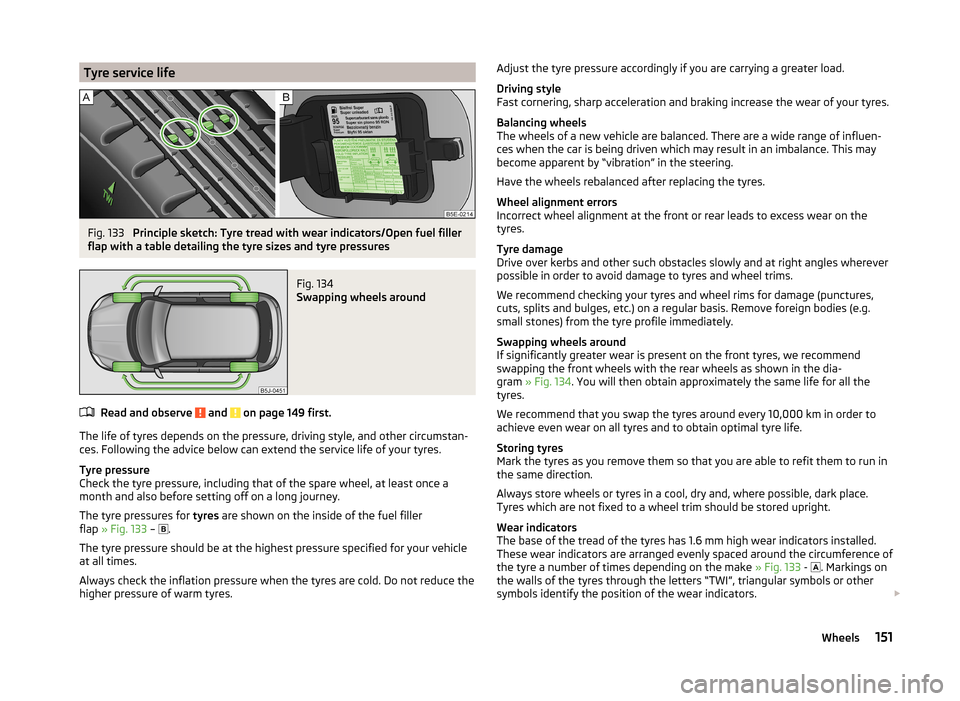
Tyre service lifeFig. 133
Principle sketch: Tyre tread with wear indicators/Open fuel filler
flap with a table detailing the tyre sizes and tyre pressures
Fig. 134
Swapping wheels around
Read and observe and on page 149 first.
The life of tyres depends on the pressure, driving style, and other circumstan-
ces. Following the advice below can extend the service life of your tyres.
Tyre pressure
Check the tyre pressure, including that of the spare wheel, at least once a
month and also before setting off on a long journey.
The tyre pressures for tyres are shown on the inside of the fuel filler
flap » Fig. 133 –
.
The tyre pressure should be at the highest pressure specified for your vehicle
at all times.
Always check the inflation pressure when the tyres are cold. Do not reduce the
higher pressure of warm tyres.
Adjust the tyre pressure accordingly if you are carrying a greater load.
Driving style
Fast cornering, sharp acceleration and braking increase the wear of your tyres.
Balancing wheels
The wheels of a new vehicle are balanced. There are a wide range of influen-
ces when the car is being driven which may result in an imbalance. This may
become apparent by “vibration” in the steering.
Have the wheels rebalanced after replacing the tyres.
Wheel alignment errors
Incorrect wheel alignment at the front or rear leads to excess wear on the
tyres.
Tyre damage
Drive over kerbs and other such obstacles slowly and at right angles wherever
possible in order to avoid damage to tyres and wheel trims.
We recommend checking your tyres and wheel rims for damage (punctures,
cuts, splits and bulges, etc.) on a regular basis. Remove foreign bodies (e.g.
small stones) from the tyre profile immediately.
Swapping wheels around
If significantly greater wear is present on the front tyres, we recommend
swapping the front wheels with the rear wheels as shown in the dia-
gram » Fig. 134 . You will then obtain approximately the same life for all the
tyres.
We recommend that you swap the tyres around every 10,000 km in order to
achieve even wear on all tyres and to obtain optimal tyre life.
Storing tyres
Mark the tyres as you remove them so that you are able to refit them to run in
the same direction.
Always store wheels or tyres in a cool, dry and, where possible, dark place.
Tyres which are not fixed to a wheel trim should be stored upright.
Wear indicators
The base of the tread of the tyres has 1.6 mm high wear indicators installed. These wear indicators are arranged evenly spaced around the circumference of
the tyre a number of times depending on the make » Fig. 133 -
. Markings on
the walls of the tyres through the letters “TWI”, triangular symbols or other
symbols identify the position of the wear indicators. 151Wheels
Page 154 of 197
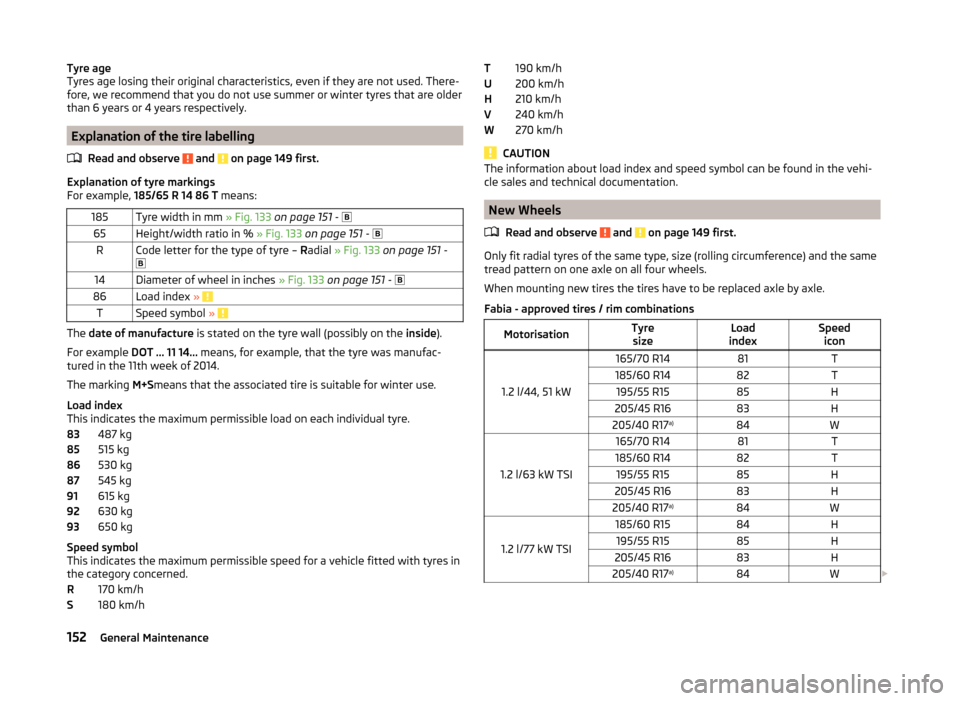
Tyre age
Tyres age losing their original characteristics, even if they are not used. There-
fore, we recommend that you do not use summer or winter tyres that are older
than 6 years or 4 years respectively.
Explanation of the tire labelling
Read and observe
and on page 149 first.
Explanation of tyre markings
For example, 185/65 R 14 86 T means:
185Tyre width in mm » Fig. 133 on page 151 - 65Height/width ratio in % » Fig. 133 on page 151 - RCode letter for the type of tyre – Radial » Fig. 133 on page 151 -
14Diameter of wheel in inches » Fig. 133 on page 151 - 86Load index » TSpeed symbol »
The date of manufacture is stated on the tyre wall (possibly on the inside).
For example DOT ... 11 14... means, for example, that the tyre was manufac-
tured in the 11th week of 2014.
The marking M+Smeans that the associated tire is suitable for winter use.
Load index
This indicates the maximum permissible load on each individual tyre.
487 kg
515 kg
530 kg
545 kg
615 kg
630 kg
650 kg
Speed symbol
This indicates the maximum permissible speed for a vehicle fitted with tyres in
the category concerned.
170 km/h
180 km/h
83858687919293RS190 km/h
200 km/h
210 km/h
240 km/h
270 km/h
CAUTION
The information about load index and speed symbol can be found in the vehi-
cle sales and technical documentation.
New Wheels
Read and observe
and on page 149 first.
Only fit radial tyres of the same type, size (rolling circumference) and the same
tread pattern on one axle on all four wheels.
When mounting new tires the tires have to be replaced axle by axle.
Fabia - approved tires / rim combinations
MotorisationTyre sizeLoad
indexSpeed icon
1.2 l/44, 51 kW
165/70 R1481T185/60 R1482T195/55 R1585H205/45 R1683H205/40 R17 a)84W
1.2 l/63 kW TSI
165/70 R1481T185/60 R1482T195/55 R1585H205/45 R1683H205/40 R17a)84W
1.2 l/77 kW TSI
185/60 R1584H195/55 R1585H205/45 R1683H205/40 R17a)84W
TUHVW152General Maintenance
Page 155 of 197
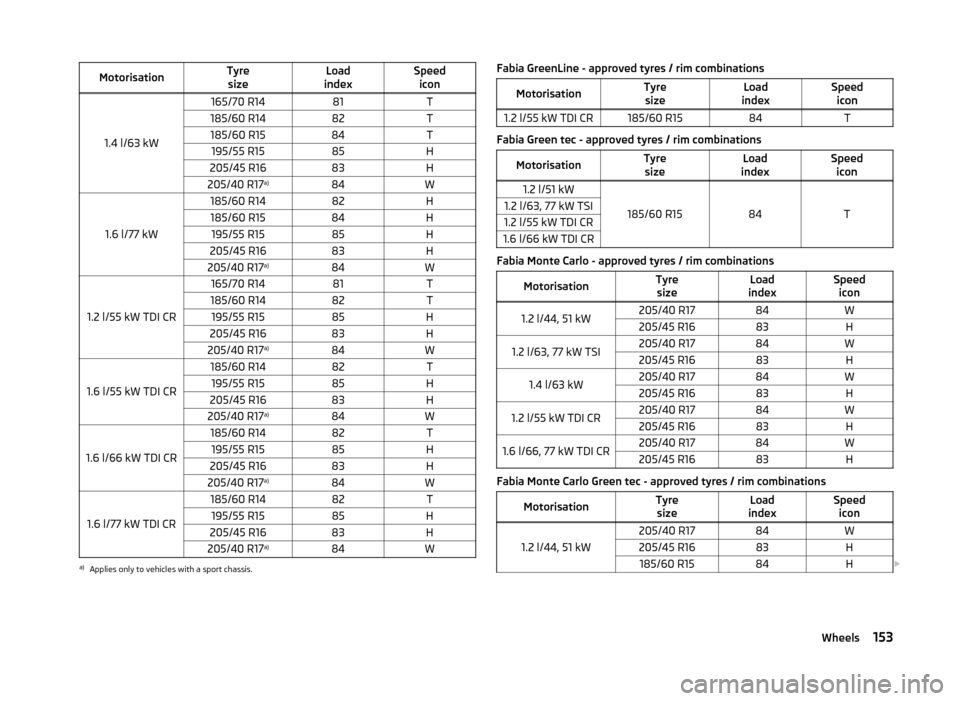
MotorisationTyresizeLoad
indexSpeed icon
1.4 l/63 kW
165/70 R1481T185/60 R1482T185/60 R1584T195/55 R1585H205/45 R1683H205/40 R17 a)84W
1.6 l/77 kW
185/60 R1482H185/60 R1584H195/55 R1585H205/45 R1683H205/40 R17a)84W
1.2 l/55 kW TDI CR
165/70 R1481T185/60 R1482T195/55 R1585H205/45 R1683H205/40 R17a)84W
1.6 l/55 kW TDI CR
185/60 R1482T195/55 R1585H205/45 R1683H205/40 R17a)84W
1.6 l/66 kW TDI CR
185/60 R1482T195/55 R1585H205/45 R1683H205/40 R17 a)84W
1.6 l/77 kW TDI CR
185/60 R1482T195/55 R1585H205/45 R1683H205/40 R17a)84Wa)
Applies only to vehicles with a sport chassis.
Fabia GreenLine - approved tyres / rim combinationsMotorisationTyre
sizeLoad
indexSpeed icon1.2 l/55 kW TDI CR185/60 R1584T
Fabia Green tec - approved tyres / rim combinations
MotorisationTyresizeLoad
indexSpeed icon1.2 l/51 kW
185/60 R1584T
1.2 l/63, 77 kW TSI1.2 l/55 kW TDI CR1.6 l/66 kW TDI CR
Fabia Monte Carlo - approved tyres / rim combinations
MotorisationTyresizeLoad
indexSpeed icon1.2 l/44, 51 kW205/40 R1784W205/45 R1683H1.2 l/63, 77 kW TSI205/40 R1784W205/45 R1683H1.4 l/63 kW205/40 R1784W205/45 R1683H1.2 l/55 kW TDI CR205/40 R1784W205/45 R1683H1.6 l/66, 77 kW TDI CR205/40 R1784W205/45 R1683H
Fabia Monte Carlo Green tec - approved tyres / rim combinations
MotorisationTyresizeLoad
indexSpeed icon
1.2 l/44, 51 kW
205/40 R1784W205/45 R1683H185/60 R1584H 153Wheels
Page 156 of 197
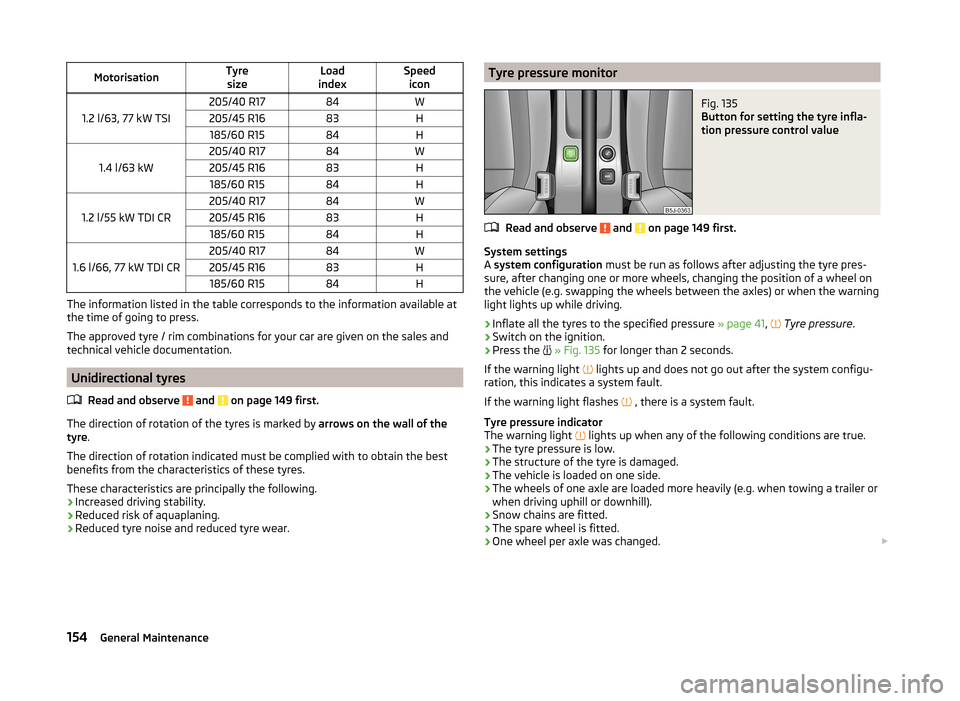
MotorisationTyresizeLoad
indexSpeed icon
1.2 l/63, 77 kW TSI
205/40 R1784W205/45 R1683H185/60 R1584H
1.4 l/63 kW
205/40 R1784W205/45 R1683H185/60 R1584H
1.2 l/55 kW TDI CR
205/40 R1784W205/45 R1683H185/60 R1584H
1.6 l/66, 77 kW TDI CR
205/40 R1784W205/45 R1683H185/60 R1584H
The information listed in the table corresponds to the information available at
the time of going to press.
The approved tyre / rim combinations for your car are given on the sales and
technical vehicle documentation.
Unidirectional tyres
Read and observe
and on page 149 first.
The direction of rotation of the tyres is marked by arrows on the wall of the
tyre .
The direction of rotation indicated must be complied with to obtain the best
benefits from the characteristics of these tyres.
These characteristics are principally the following.
› Increased driving stability.
› Reduced risk of aquaplaning.
› Reduced tyre noise and reduced tyre wear.
Tyre pressure monitorFig. 135
Button for setting the tyre infla-
tion pressure control value
Read and observe and on page 149 first.
System settings
A system configuration must be run as follows after adjusting the tyre pres-
sure, after changing one or more wheels, changing the position of a wheel on
the vehicle (e.g. swapping the wheels between the axles) or when the warning
light lights up while driving.
›
Inflate all the tyres to the specified pressure » page 41,
Tyre pressure
.
›
Switch on the ignition.
›
Press the
» Fig. 135 for longer than 2 seconds.
If the warning light lights up and does not go out after the system configu-
ration, this indicates a system fault.
If the warning light flashes , there is a system fault.
Tyre pressure indicator
The warning light lights up when any of the following conditions are true.
› The tyre pressure is low.
› The structure of the tyre is damaged.
› The vehicle is loaded on one side.
› The wheels of one axle are loaded more heavily (e.g. when towing a trailer or
when driving uphill or downhill).
› Snow chains are fitted.
› The spare wheel is fitted.
› One wheel per axle was changed.
154General Maintenance
Page 159 of 197
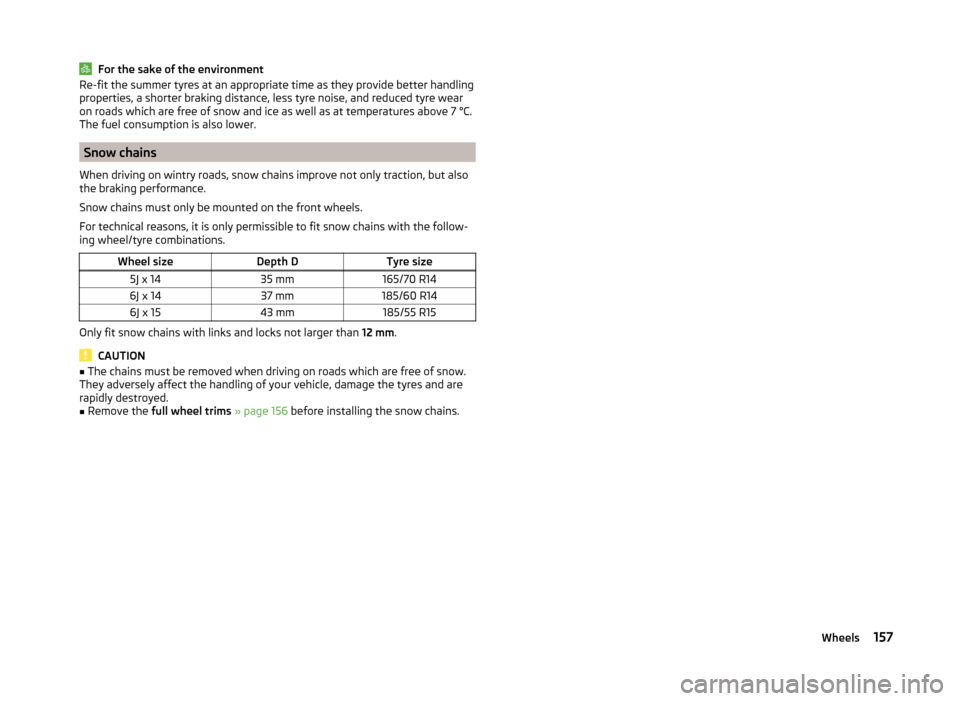
For the sake of the environmentRe-fit the summer tyres at an appropriate time as they provide better handling
properties, a shorter braking distance, less tyre noise, and reduced tyre wear
on roads which are free of snow and ice as well as at temperatures above 7 °C.
The fuel consumption is also lower.
Snow chains
When driving on wintry roads, snow chains improve not only traction, but also
the braking performance.
Snow chains must only be mounted on the front wheels.
For technical reasons, it is only permissible to fit snow chains with the follow-
ing wheel/tyre combinations.
Wheel sizeDepth DTyre size5J x 1435 mm165/70 R146J x 1437 mm185/60 R146J x 1543 mm185/55 R15
Only fit snow chains with links and locks not larger than 12 mm.
CAUTION
■
The chains must be removed when driving on roads which are free of snow.
They adversely affect the handling of your vehicle, damage the tyres and are
rapidly destroyed.■
Remove the full wheel trims » page 156 before installing the snow chains.
157Wheels
Page 164 of 197
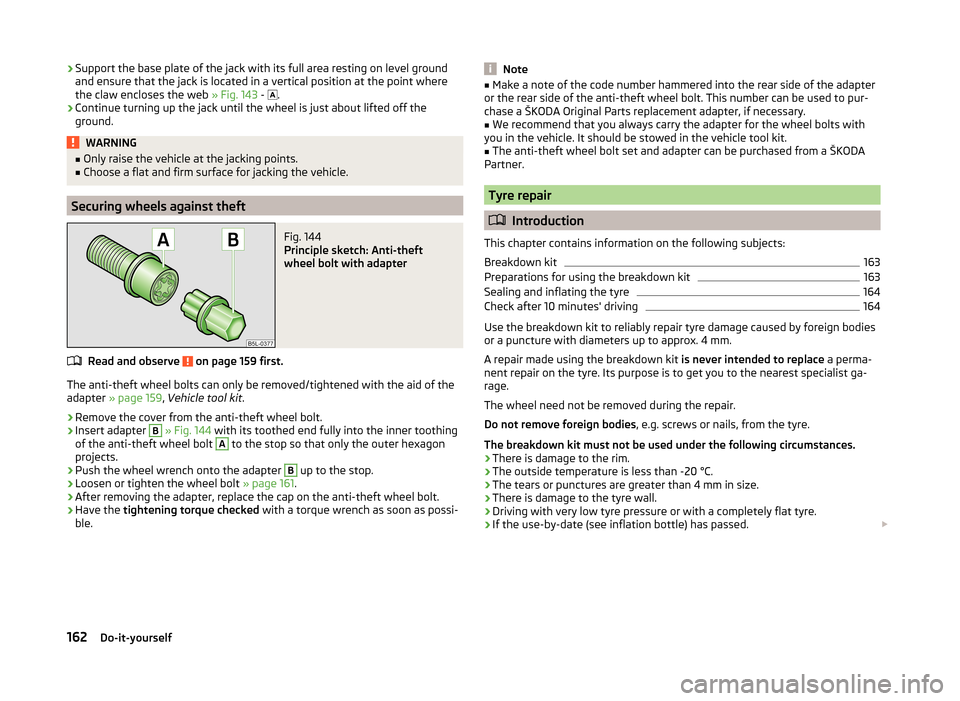
›Support the base plate of the jack with its full area resting on level ground
and ensure that the jack is located in a vertical position at the point where
the claw encloses the web » Fig. 143 -
.›
Continue turning up the jack until the wheel is just about lifted off the
ground.
WARNING■ Only raise the vehicle at the jacking points.■Choose a flat and firm surface for jacking the vehicle.
Securing wheels against theft
Fig. 144
Principle sketch: Anti-theft
wheel bolt with adapter
Read and observe on page 159 first.
The anti-theft wheel bolts can only be removed/tightened with the aid of the
adapter » page 159 , Vehicle tool kit .
›
Remove the cover from the anti-theft wheel bolt.
›
Insert adapter
B
» Fig. 144 with its toothed end fully into the inner toothing
of the anti-theft wheel bolt
A
to the stop so that only the outer hexagon
projects.
›
Push the wheel wrench onto the adapter
B
up to the stop.
›
Loosen or tighten the wheel bolt » page 161.
›
After removing the adapter, replace the cap on the anti-theft wheel bolt.
›
Have the tightening torque checked with a torque wrench as soon as possi-
ble.
Note■ Make a note of the code number hammered into the rear side of the adapter
or the rear side of the anti-theft wheel bolt. This number can be used to pur-
chase a ŠKODA Original Parts replacement adapter, if necessary.■
We recommend that you always carry the adapter for the wheel bolts with
you in the vehicle. It should be stowed in the vehicle tool kit.
■
The anti-theft wheel bolt set and adapter can be purchased from a ŠKODA
Partner.
Tyre repair
Introduction
This chapter contains information on the following subjects:
Breakdown kit
163
Preparations for using the breakdown kit
163
Sealing and inflating the tyre
164
Check after 10 minutes' driving
164
Use the breakdown kit to reliably repair tyre damage caused by foreign bodies
or a puncture with diameters up to approx. 4 mm.
A repair made using the breakdown kit is never intended to replace a perma-
nent repair on the tyre. Its purpose is to get you to the nearest specialist ga-
rage.
The wheel need not be removed during the repair.
Do not remove foreign bodies , e.g. screws or nails, from the tyre.
The breakdown kit must not be used under the following circumstances. › There is damage to the rim.
› The outside temperature is less than -20 °C.
› The tears or punctures are greater than 4 mm in size.
› There is damage to the tyre wall.
› Driving with very low tyre pressure or with a completely flat tyre.
› If the use-by-date (see inflation bottle) has passed.
162Do-it-yourself